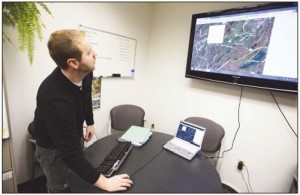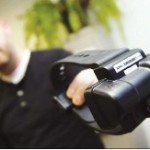by Bruce A. Scruton of the New Jersey Herald
bscruton@njherald.com

Mark Turtur, juvenile detention supervision officer, displays a map in the Sussex County Administration Building in Newton that shows pin points of a client that were created as the client traveled through Sussex County while wearing an ankle bracelet tracking system.
NEWTON – At 7:24 p.m., the subject was doing 1 mph, apparently stopped at the intersection of Routes 10 and 46. A minute later, she was on Route 10 doing 37 mph.
At 7:26p.m., her vehicle turned onto Hunter Street, approaching Main Street and moving at 14 mph. The Google map presentation on the computer screen showed she was almost to a church, neatly outlined in blue.
“That blue indicates an approved place,” said Mark Turtur, supervising juvenile detention officer in the Sussex County Department of Human Services, as he described the GPS tracking record being shown on the computer.
“She” is an unnamed juvenile who was assigned to the detention alternatives program last year. As part of the program, she wore a GPS unit strapped to her ankle which monitored her movements 24/7 and, as a demonstration, Turtur pulled up a computer record of a day in her life.
Sussex County is now in its sixth year of using the “trackers,” as the anklets are known, and has seen 225 youths go through the court-ordered process as an alternative to a jail cell.
“In the detention center, they are just sitting there,” said Turtur. “In the program, things are better right away.”
The county has six detention officers, with Turtur as their supervisor and Kristen M. Thompson, senior program development specialist, also on the team of eight that can supervise as many as a dozen juveniles at a time.
Active Monitoring 24/7
While more than half the counties in New Jersey use some form of GPS monitoring, Sussex is the only county that uses the active monitoring on a 24/7 basis.
The detention officers all work the same 4 p.m.-to-midnight shift and during that shift, each of the juveniles gets a home visit from an officer.
However, the computer is watching around the clock and can send a text alert to any or all of the team members. A quick check of a computer will give up-to-the-minute data on where the juvenile is and the reason for the alert.
Each participant – there were two it in the program as of mid-week – has his/her own set of parameters that specify what time they are expected to be where. The program is updated constantly, depending on the daily visits and the changing schedule, whether it be school rips, doctor visit, pre-approved trips and counseling sessions.
One time an anklet-wearing youth wanted to cross the street to get a snack from a gas station.
“We got the alarm that he had gone out of bounds,” said Turtur. “When we called (his home), he was out of breath (from running across the street and back) and said he thought he could cross the street quick enough.”
Another time, the officers used the computer program to track where a girl in the program had gone to set off the out-of-bounds notification at school.
It turned out, she was still on school property but went to smoke a cigarette.
“When we told the school officials, they told us they were wondering where the new place was because they had caught students at the old place,” said Turtur.
Tampering Alert
The nearly indestructible anklets also have built-in sensors to sound an alert if there is tampering.
Turtur said the team responded to one such tampering call and in trying to take off the anklet to check for a possible malfunction, found he wearer had pulled out some pins, which sounded the alarm, then glued the pins back in.
The program began in 2010 when the Sussex County Board of Chosen Freeholders decided to close the county’s youth detention facility in Frankford and instead reserve four cells per day at the Morris County facility.
The program proved successful and in 2011 the county dropped to reserving just three beds per day.
At the same time, the county also contracted with Morris County for four beds at the youth shelter, a non-secure facility that houses youth we are taken from the home. In 2011, the number of reserved beds were dropped to two per day.
- Mark Turtur, juvenile detention supervising officer, holds an ankle bracelet tracker.
- Christine Florio, head of the youth services bureau within the Sussex County Department of Human Services, discussing the tracking program.
- Kristen Thompson, senior program development specialist, is discussing the tracking program.
Christine Florio, who heads the county’s Bureau of Youth Services, said, “The priority now is to keep them in the community and in their home. We’re finding very few get in trouble and it’s the best possible scenario for most of these youths.”
Each day during the detention offer’s visit, any changes to the daily schedule are discussed and approved changes are noted and logged into the computer.
Youths are assigned to the program by a Family court judge and progress is reported back to the court which can modify the overall program.
Although the officer is there to check on the youth, seeing them in the home allows for much greater interaction.
“We have some officers who end up helping with homework, even teaching them how to clean their room,” said Florio.
Steve Gruchacz, administrator for the Department of Human Services, said the active computer program “is innovative. It not only helps with keeping the clients compliant, but with case management. We know their movements, we know if they are keeping their appointments for counseling and professional help.”
He said the department is likely to be presenting the county’s detention alternatives program during the annual New Jersey Association of Counties convention in May.
In the first five years, the county’s program has had at least an 82 percent success rate of juveniles who have completed the program and been released. Success is measured by a client being linked to a local service provider, such as substance abuse treatment, anger management, life skills or individual counseling.
They must have also appeared at scheduled court hearing, probation reporting and other court-ordered treatment services.
Last year, 33 youths – 27 males and six females – were admitted to the program with 29 counted as successful and are no longer in the program. The “unsuccessful” ones may have remained longer in the program or been assigned a more severe punishment by a judge.
“We have been highly successful,” said Thompson. “And if I regret anything, it’s we didn’t start something like this earlier.”
Bruce A. Scruton can also be contacted on Twitter @brucescrutonNJH or by phone: 973-383-1224



